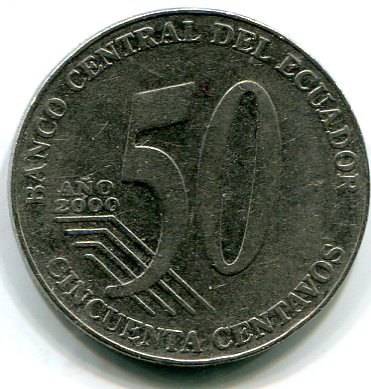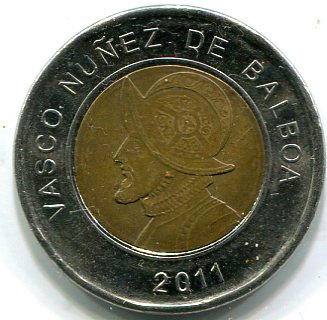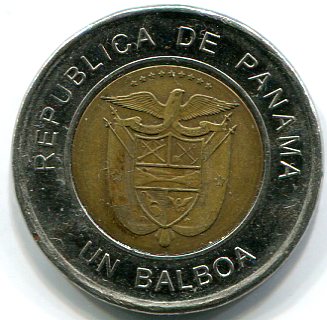Hard to believe Canada Day’s rolled around again. Time to honor our neighbors up north by watching one of their major cultural achievements. Other episodes are also available on YouTube.
Lilly brought us souvenirs from her trip to Latin America — omiyagi, to use the Japanese term, which means souvenirs specially obtained for people who didn’t make the trip. It’s a custom we follow.
She got me three things, all showing that she knows her dad pretty well: coins, postcards and Ecuadorean chocolate. As it happens, both Ecuador and Panama are dollarized economies. No currency exchange was necessary; she took greenback cash and also withdrew funds, in dollars, from an ATM.
The small change is each country’s own. This is 50 centavos from Ecuador, obverse.
 It features the face of one José Eloy Alfaro Delgado (1842-1912), who was president of Ecuador from 1895 to 1901 and from 1906 to 1911, and had the distinction of being assassinated by anti-secularizers, since he introduced the likes of civil marriage and divorce, and secular eduction, to his nation. He also oversaw the construction of the Ferrocarril Transandino (Trans-Andean Railroad) connecting Guayaquil and Quito.
It features the face of one José Eloy Alfaro Delgado (1842-1912), who was president of Ecuador from 1895 to 1901 and from 1906 to 1911, and had the distinction of being assassinated by anti-secularizers, since he introduced the likes of civil marriage and divorce, and secular eduction, to his nation. He also oversaw the construction of the Ferrocarril Transandino (Trans-Andean Railroad) connecting Guayaquil and Quito.
The reserve.
 The steel Ecuadorean coins are made at mints in Canada and Mexico. Other denominations include 25c, 10c, 5c, and (supposedly) 1c. Lilly brought back the first three of that list, and along with the 50c piece, I checked their sizes. They’re exactly the same size as their respective U.S. coins.
The steel Ecuadorean coins are made at mints in Canada and Mexico. Other denominations include 25c, 10c, 5c, and (supposedly) 1c. Lilly brought back the first three of that list, and along with the 50c piece, I checked their sizes. They’re exactly the same size as their respective U.S. coins.
Apparently Ecuador doesn’t issue dollar coins. Lilly said that U.S. dollar coins are in circulation there much more than they are in the United States. If we’d known that, I’d have given her a roll or two of dollar coins to take with her.
Panama, on the other hand, does have its own dollar-equivalent coin, the bimetallic balboa, which Lilly tells me circulates with U.S. dollar coins.
 Who else to put on the balboa than Balboa? The man who lost his head over Panama. Here’s something I didn’t know: there’s a crater on the Moon named for him. He might have made it to the Pacific, but I’m pretty sure he didn’t get that far.
Who else to put on the balboa than Balboa? The man who lost his head over Panama. Here’s something I didn’t know: there’s a crater on the Moon named for him. He might have made it to the Pacific, but I’m pretty sure he didn’t get that far.
The reverse.
 It’s hard to see, but the coat of arms of Panama includes a depiction of the isthmus, a sword, rifle, shovel, hoe, and more. The eagle is specifically — according to recent Panamanian law — a harpy eagle (Harpia harpyja), the national bird. The impossible-to-read motto is Pro Mundi Beneficio, for the benefit of the world.
It’s hard to see, but the coat of arms of Panama includes a depiction of the isthmus, a sword, rifle, shovel, hoe, and more. The eagle is specifically — according to recent Panamanian law — a harpy eagle (Harpia harpyja), the national bird. The impossible-to-read motto is Pro Mundi Beneficio, for the benefit of the world.